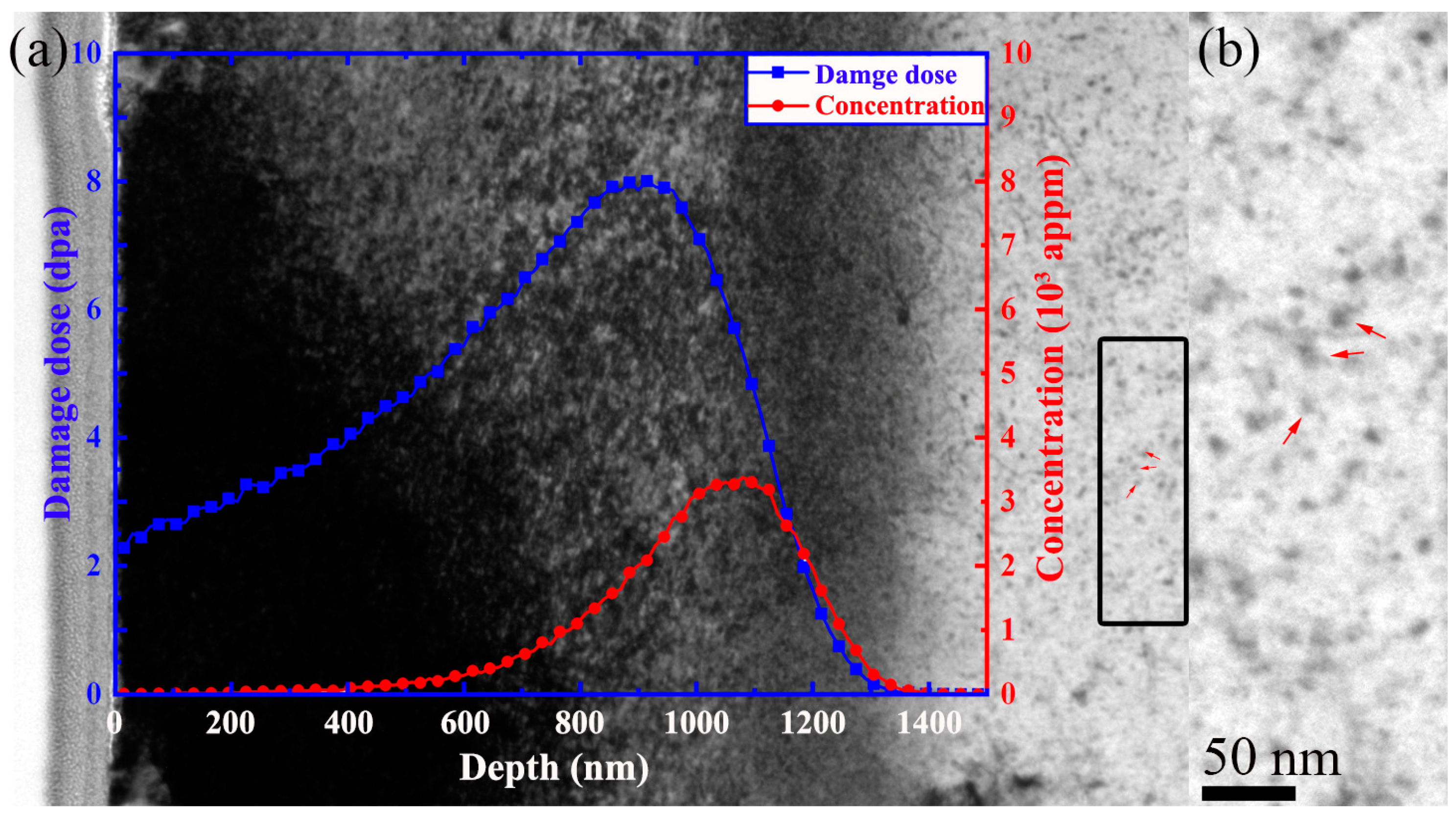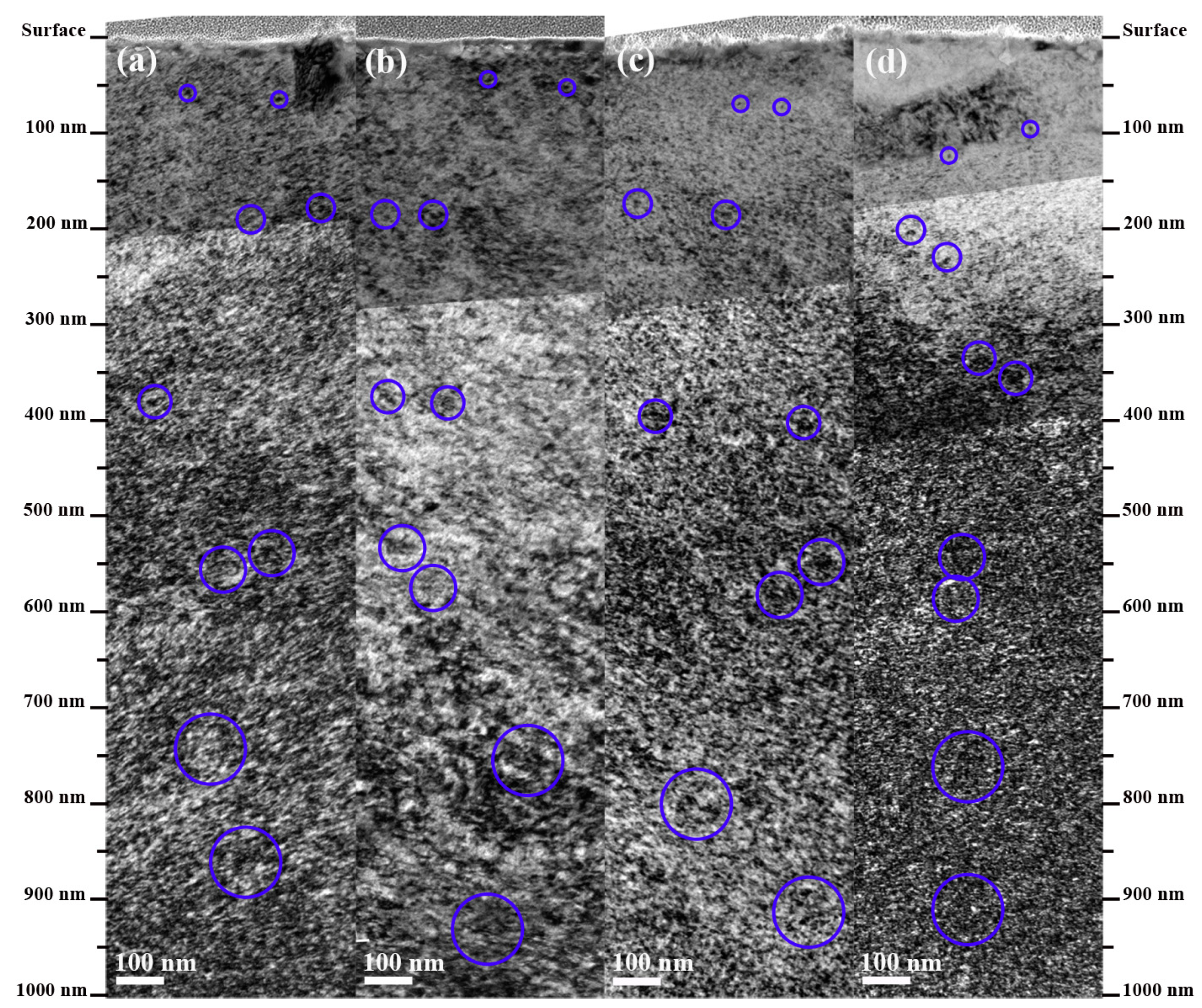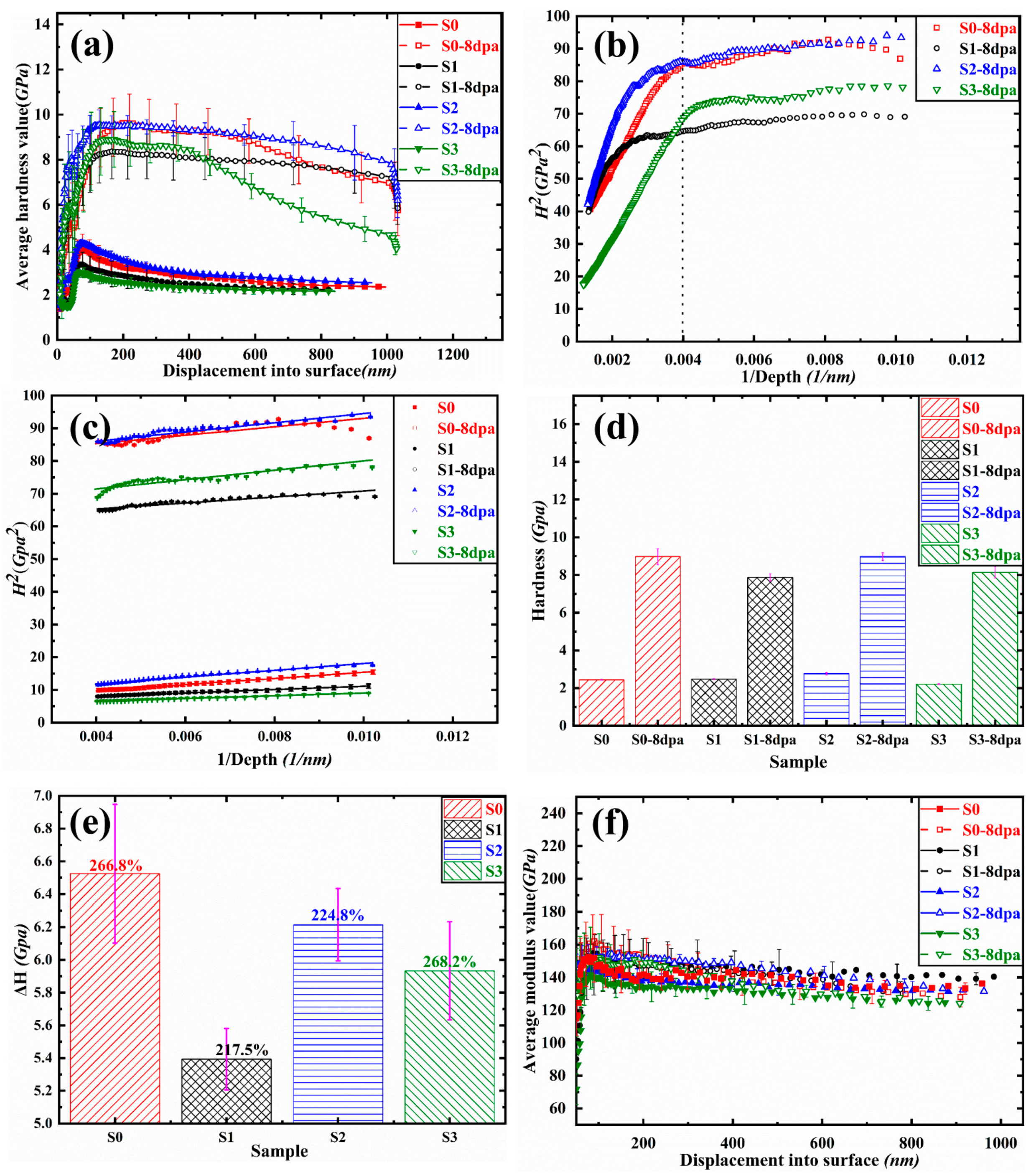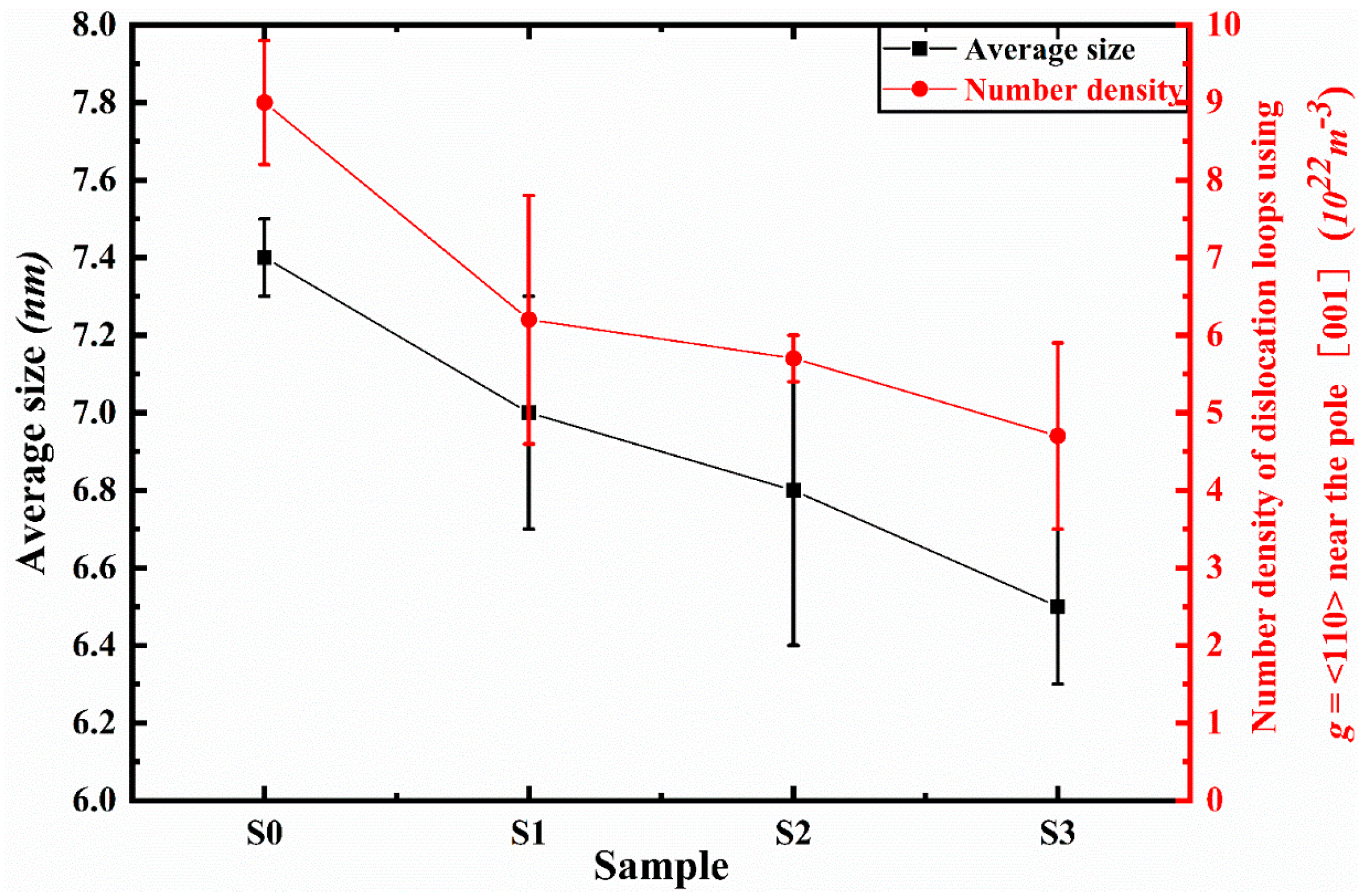The Effect of Yttrium Addition on the Microstructure and Irradiation Hardening in V-4Cr-4Ti Alloy under Self-Ion Irradiation
Abstract
:1. Introduction
2. Materials and Methods
2.1. Self-Ion Irradiation
2.2. TEM Observation
2.3. Nano-Indentation Test
3. Results
3.1. TEM Observation of Microstructure
3.2. Irradiation Hardening
4. Discussion
4.1. The Effect of Y Addition on the Size and Number Densities of the Dislocation Loops
4.2. Irradiation Hardening
5. Conclusions
- Dense dislocation loops could be found after irradiation in all V-4Cr-4Ti-xY alloys. With the increase of Y addition, the size and number densities of dislocation loops under the g = <110> condition near pole [001] decrease.
- Obvious irradiation hardening was found in all V-4Cr-4Ti-xY alloys. With the increase of Y addition, the hardness increment first decreases and then increases, according to the nano-indentation test.
- Considered comprehensively, the component of V-4Cr-4Ti-0.1Y alloy is much more advantageous and deserves further study compared with other kinds of V-4Cr-4Ti-xY alloys in this paper.
Author Contributions
Funding
Data Availability Statement
Acknowledgments
Conflicts of Interest
References
- Kurtz, R.J.; Abe, K.; Chernov, V.M.; Hoelzer, D.T.; Matsui, H.; Muroga, T.; Odette, G.R. Recent Progress on Development of Vanadium Alloys for Fusion. J. Nucl. Mater. 2004, 329–333, 47–55. [Google Scholar] [CrossRef]
- Muroga, T.; Nagasaka, T.; Abe, K.; Chernov, V.M.; Matsui, H.; Smith, D.L.; Xu, Z.Y.; Zinkle, S.J. Vanadium Alloys—Overview and Recent Results. J. Nucl. Mater. 2002, 307–311, 547–554. [Google Scholar] [CrossRef]
- Zinkle, S.J.; Matsui, H.; Smith, D.L.; Rowcliffe, A.F.; Van Osch, E.; Abe, K.; Kazakov, V.A. Research and Development on Vanadium Alloys for Fusion Applications. J. Nucl. Mater. 1998, 258–263, 205–214. [Google Scholar] [CrossRef]
- Muroga, T.; Chen, J.M.; Chernov, V.M.; Kurtz, R.J.; Le Flem, M. Present Status of Vanadium Alloys for Fusion Applications. J. Nucl. Mater. 2014, 455, 263–268. [Google Scholar] [CrossRef]
- Cao, X.; Li, Q.; Shi, Y.; Wu, D.; Xue, X. Preparation of v–4cr–4ti Alloys from Mixed Oxides via Electro-Deoxidation Process in Molten Salt. Metals 2020, 10, 1067. [Google Scholar] [CrossRef]
- Tyumentsev, A.N.; Korotaev, A.D.; Pinzhin, Y.P.; Ditenberg, I.A.; Litovchenko, S.V.; Shuba, Y.V.; Shevchenko, N.V.; Drobishev, V.A.; Potapenko, M.M.; Chernov, V.M. Effect of the Modes of Thermomechanical Treatment on the Formation of the Multiphase and Grain Structure of V-4Ti-4Cr Alloys. J. Nucl. Mater. 2004, 329–333, 429–433. [Google Scholar] [CrossRef]
- Su, Y.; Xia, S.; Huang, J.; Liu, Q.; Liu, H.; Wang, C.; Wang, Y. Irradiation Behaviors in Bcc Multi-Component Alloys with Different Lattice Distortions. Metals 2021, 11, 706. [Google Scholar] [CrossRef]
- Nagasaka, T.; Muroga, T.; Hino, T.; Satou, M.; Abe, K.; Chuto, T.; Iikubo, T. Impurity Behavior in V-4Cr-4Ti-Y Alloys Produced by Levitation Melting. J. Nucl. Mater. 2007, 367–370, 823–828. [Google Scholar] [CrossRef] [Green Version]
- Qiu, G.; Zhan, D.; Li, C.; Qi, M.; Yang, Y.; Jiang, Z.; Zhang, H. Effects of Yttrium on Microstructure Stability and Tensile Properties of China Low Activation Martensitic Steel. Metals 2019, 9, 446. [Google Scholar] [CrossRef] [Green Version]
- Kobayashi, S.; Tsuruoka, Y.; Nakai, K.; Kurishita, H. Effect of Neutron Irradiation on the Microstructure and Hardness in Particle Dispersed Ultra-Fine Grained V-Y Alloys. J. Nucl. Mater. 2004, 329–333, 447–451. [Google Scholar] [CrossRef]
- Watanabe, H.; Yamasaki, K.; Higashijima, A.; Taguma, H.; Nagasaka, T.; Muroga, T. Microstructural Changes of Y-Doped V-4Cr-4Ti Alloys after Ion and Neutron Irradiation. Nucl. Mater. Energy 2016, 9, 447–450. [Google Scholar] [CrossRef] [Green Version]
- Ding, J.; Yang, S.; Zhu, B.; Liu, H.; Liu, G.; Zhou, L.; Zhan, Q.; Wan, F. Twins Induced by High-Temperature Ion Irradiation in Body-Centered Cubic V-4Cr-4Ti Alloy. Scr. Mater. 2019, 162, 377–381. [Google Scholar] [CrossRef]
- Ochiai, K.; Watanabe, H.; Muroga, T.; Yoshida, N.; Matsui, H. Microstructural Evolution in Vanadium Irradiated during Ion Irradiation at Constant and Varying Temperature. J. Nucl. Mater. 1999, 271–272, 376–380. [Google Scholar] [CrossRef]
- Chernov, I.I.; Stal’tsov, M.S.; Kalin, B.A.; Zaw, A.K.; Drozhzhina, M.V.; Nikolaeva, I.D.; Romanov, V.A.; Bazhal, S.V.; Glotov, A.I.; Lagov, P.B. Particularities of Vanadium Microstructure Development During Irradiation by 7.5 MeV Ni2+ Ions at 650 °C. At. Energy 2015, 118, 400–404. [Google Scholar] [CrossRef]
- Miyazawa, T.; Nagasaka, T.; Kasada, R.; Hishinuma, Y.; Muroga, T.; Watanabe, H.; Yamamoto, T.; Nogami, S.; Hatakeyama, M. Evaluation of Irradiation Hardening of Ion-Irradiated V-4Cr-4Ti and V-4Cr-4Ti-0.15Y Alloys by Nanoindentation Techniques. J. Nucl. Mater. 2014, 455, 440–444. [Google Scholar] [CrossRef]
- Wang, B.; Haque, M.A.; Tomar, V.; Hattar, K. Self-Ion Irradiation Effects on Mechanical Properties of Nanocrystalline Zirconium Films. MRS Commun. 2017, 7, 595–600. [Google Scholar] [CrossRef]
- Shao, L.; Wei, C.C.; Gigax, J.; Aitkaliyeva, A.; Chen, D.; Sencer, B.H.; Garner, F.A. Effect of Defect Imbalance on Void Swelling Distributions Produced in Pure Iron Irradiated with 3.5 MeV Self-Ions. J. Nucl. Mater. 2014, 453, 176–181. [Google Scholar] [CrossRef]
- Zhang, Y.F.; Du, J.K.; Liu, P.P.; Zheng, P.F.; Yang, S.W.; Wan, F.R.; Zhan, Q. Response of Microstructure and Hardening to Deuterium Ion Irradiation InV-4Cr-4Ti-1.8Y-0.4Ti3SiC2 and V-4Cr-4Ti Alloy. Fusion Eng. Des. 2020, 159. [Google Scholar] [CrossRef]
- Nix, W.D.; Gao, H. Indentation Size Effects in Crystalline Materials: A Law for Strain Gradient Plasticity. J. Mech. Phys. Solids 1998, 46, 411–425. [Google Scholar] [CrossRef]
- Pharr, G.M.; Herbert, E.G.; Gao, Y. The Indentation Size Effect: A Critical Examination of Experimental Observations and Mechanistic Interpretations. Annu. Rev. Mater. Res. 2010, 40, 271–292. [Google Scholar] [CrossRef]
- Saha, R.; Nix, W.D. Effects of the Substrate on the Determination of Thin Film Mechanical Properties by Nanoindentation. Acta Mater. 2002, 50, 23–38. [Google Scholar] [CrossRef]
- Candra, Y.; Fukumoto, K.; Kimura, A.; Matsui, H. Microstructural Evolution and Hardening of Neutron Irradiated Vanadium Alloys at Low Temperatures in Japan Material Testing Reactor. J. Nucl. Mater. 1999, 271–272, 301–305. [Google Scholar] [CrossRef]
- Chuto, T.; Satou, M.; Hasegawa, A.; Abe, K.; Muroga, T.; Yamamoto, N. Effects of Small Amount of Additional Elements on Control of Interstitial Impurities and Mechanical Properties of V-4Cr-4Ti-Si-Al-Y Alloys. J. Nucl. Mater. 2004, 326, 1–8. [Google Scholar] [CrossRef]
- Zhang, C.; Zhang, P.; Li, R.; Zhao, J.; Dong, C. Stability and Migration of Vacancy in V-4Cr-4Ti Alloy: Effects of Al, Si, y Trace Elements. J. Nucl. Mater. 2013, 442, 370–376. [Google Scholar] [CrossRef]
- Nishizawa, T.; Sasaki, H.; Ohnuki, S.; Takahashi, H.; Shibayama, T.; Kayano, H. Radiation Damage Process of Vanadium and Its Alloys during Electron Irradiation. J. Nucl. Mater. 1996, 239, 132–138. [Google Scholar] [CrossRef]
- Zhang, P.; Li, S.X.; Zhang, Z.F. General Relationship between Strength and Hardness. Mater. Sci. Eng. A 2011, 529, 62–73. [Google Scholar] [CrossRef]
- Wang, Z.Q.; Zhao, Q.; Wei, Y.P.; Liu, P.P.; Yang, S.W.; Wan, F.R.; Zhan, Q. The Direct Correlation between Precipitate-Size-Dependent Strain at the Interface and the Irradiation Hardening in V-4Cr-4Ti. J. Alloys Compd. 2018, 732, 406–413. [Google Scholar] [CrossRef]
- Peng, L.; Jiang, C.; Li, X.; Zhou, P.; Li, Y.; Lai, X. The Formation of Precipitates and Its Effect on Grain Structure in V-4Cr-4Ti Alloys with Yttrium Addition. J. Alloys Compd. 2017, 694, 1165–1174. [Google Scholar] [CrossRef]
- Nagasaka, T.; Muroga, T.; Watanabe, H.; Yamasaki, K.; Heo, N.J.; Shinozaki, K.; Narui, M. Recovery of Hardness, Impact Properties and Microstructure of Neutron-Irradiated Weld Joint of a Fusion Candidate Vanadium Alloy. Mater. Trans. 2005, 46, 498–502. [Google Scholar] [CrossRef] [Green Version]
- Miyazawa, T.; Nagasaka, T.; Hishinuma, Y.; Muroga, T.; Li, Y. Moderation of Negative Oxygen Effects by Small Yttrium Addition to Low Activation Vanadium Alloys. Fusion Sci. Technol. 2011, 60, 407–411. [Google Scholar] [CrossRef]





| Sample | Average Size (nm) | Number Density (1022 m−3) | ΔHnano (GPa) |
|---|---|---|---|
| S0 | 7.4 ± 0.1 | 9.0 ± 0.8 | 6.5 ± 0.4 |
| S1 | 7.0 ± 0.3 | 6.2 ± 1.6 | 5.4 ± 0.2 |
| S2 | 6.8 ± 0.4 | 5.7 ± 0.3 | 6.2 ± 0.2 |
| S3 | 6.5 ± 0.2 | 4.7 ± 1.2 | 5.9 ± 0.3 |
Publisher’s Note: MDPI stays neutral with regard to jurisdictional claims in published maps and institutional affiliations. |
© 2021 by the authors. Licensee MDPI, Basel, Switzerland. This article is an open access article distributed under the terms and conditions of the Creative Commons Attribution (CC BY) license (https://creativecommons.org/licenses/by/4.0/).
Share and Cite
Luo, H.; Luo, F.; Chen, Y.; Wang, J.; Liu, Q.; Li, F.; Zhou, X.; Guo, L. The Effect of Yttrium Addition on the Microstructure and Irradiation Hardening in V-4Cr-4Ti Alloy under Self-Ion Irradiation. Metals 2021, 11, 1024. https://doi.org/10.3390/met11071024
Luo H, Luo F, Chen Y, Wang J, Liu Q, Li F, Zhou X, Guo L. The Effect of Yttrium Addition on the Microstructure and Irradiation Hardening in V-4Cr-4Ti Alloy under Self-Ion Irradiation. Metals. 2021; 11(7):1024. https://doi.org/10.3390/met11071024
Chicago/Turabian StyleLuo, Hongtai, Fengfeng Luo, Yiheng Chen, Jiawei Wang, Qiuxiang Liu, Fang Li, Xiong Zhou, and Liping Guo. 2021. "The Effect of Yttrium Addition on the Microstructure and Irradiation Hardening in V-4Cr-4Ti Alloy under Self-Ion Irradiation" Metals 11, no. 7: 1024. https://doi.org/10.3390/met11071024






